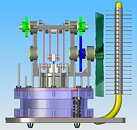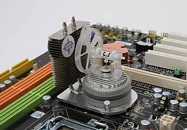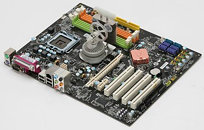Friday, February 29th 2008

MSI Working on ‘Powerless’ CPU Cooler
MSI has taken a step to try and reduce computer power consumption slightly by building a processor fan that is powered using only heat given off by the CPU. As the processor heats up, it causes air inside a piston to expand. That forces out the piston rod, which in turn causes the fan to spin and blow air over the heatsink, as shown in the first image below. This then helps to cool the air inside the piston, causing it to contract again, pulling the piston rod back in and cooling the CPU without needing any extra electricity. The technology is by no means a modern idea - it uses a mechanism invented in 1816 by Scottish engineer Robert Stirling - but it's never before been used on a large scale for computing purposes. MSI's fan is capable of converting 70% of the heat energy given off by the CPU into kinetic energy, and the company plans to demo the cooler at next week's CeBIT show in Hanover. However, there is no news of when this fan will become available for purchase, or what prices will be like.
Source:
Reg Hardware



54 Comments on MSI Working on ‘Powerless’ CPU Cooler
If it could be used in a laptop where every watt matters in battery life then it might be worth the added cost but in a desktop where your save maybe two cents off the electric bill a year:ohwell: Still cool though:D
edit: then again I already have a passive NB heatpipecooler :)
120mm fans are around 1-1.5W and 3.5" fans are around 6-8W (iirc), except for those new Western Digital Green Power drives.
Why? Well they produce less heat, so in theory should overclock more than their less efficient partners.
I like my PC to be powerful, cool running, and near silent, and if "low power" variants get me that, bring it on! :D
Now your pc can sound like a model train. If its got a piston and compression then its going to have noise... putt putt putt putt........ :laugh:
And it's very very very quiet too! :D:D:D
So I think this thing is pointless! Maybe when it's producing some energy!
Imagine small devices like that and the heat from the hole Rig powering my Lava Lamp! :D:D:D
Anyway, the Stirling engine runs more efficiently when there is a greater differential between the cool side and the hot side. This means that the cooling of the fins is critical in maintaining the efficiency of the device.
The problem with a device like this, is that it needs to be tuned to be as efficient as possible given the differential sources. I think it would work well if tuned for a system with all parameters known, but as soon as you throw OC'ing, or case cooloing variable, into the equation you will lose the "sweet spot" of efficiency.
Something more interesting about the Stirling engine is that it works in both directions. If you power the pistons, you can get a cryocooling effect on the cold side. I think this may be more interesting ot OC'ers than the "heat engine".
Physics FTW !!
Stirling engines do have one significant problem though, they can tend to be slow to get going from cold. If a CPU got hot really quickly, the pump may lag too far behind and then make your day sad. Using a bigger capacity pump won't solve this issue as it will be even slower to get going. In this case, I think a substantial heat sink would be needed to ensure the temperature ripples are ironed out.
as to the people who mention dust etc - they COULD use plastic casing around the moving parts. This may work better than we think, since the heat is what moves it, the heat is actually being used to power the fan, which cools it even more - its double action. Combine this with a full sized tower heatsink, and we could have a winnar.
Look at it this way - heatpipes and giant tower coolers were gimmicks when they first came out, and they're both widely accepted now. Hell, 3rd party cooling was unheard of when i started computing. Give this time, it could be part of a new shiny era of cooling.
Also, as said this will still run when the PC is off for a few minutes(?), which helps.
Everyone stop being hippies about this. Hippies smell bad.
The amount of energy this will save is negligible.
Second,
This is cool. I mean, really, if I could buy one of these separate, I would, as long as it had a connector with the tach wire.
Chris